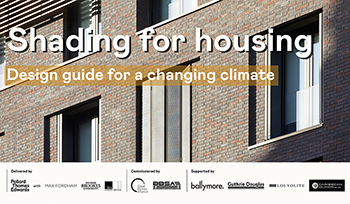Advanced construction technology
The construction industry is repeatedly criticised for being inefficient and slow to innovate. The basic methods of construction, techniques and technologies have changed little since Roman times. But the application of innovation in the construction industry is not straight forward.
Every construction project is different, every site is a singular prototype, construction works are located in different places, and involve the constant movement of personnel and machinery. In addition, the weather and other factors can prevent the application of previous experience effectively.
The term 'advanced construction technology' covers a wide range of modern techniques and practices that encompass the latest developments in materials technology, design procedures, quantity surveying, facilities management, services, structural analysis and design, and management studies.
Incorporating advanced construction technology into practice can increase levels of quality, efficiency, safety, sustainability and value for money. However, there is often a conflict between traditional industry methods and innovative new practices, and this is often blamed for the relatively slow rate of technology transfer within the industry.
The adoption of advanced construction technology requires an appropriate design, commitment from the whole project team, suitable procurement strategies, good quality control, appropriate training and careful commissioning.
Advanced construction technologies are commonly described as including (amongst many others) advanced forms of:
- 3D printing.
- Materials.
- Building information modeling (BIM).
- Cladding systems.
- Computer aided design and computer aided manufacturing (CAD/CAM).
- Computer numerical control.
- Construction Innovation Hub.
- Construction plant.
- Modern methods of construction.
- Modular construction.
- Offsite manufacturing.
- Prefabrication and preassembly.
- Research and development.
- Site investigations and surveying.
- Substructure works.
- Water engineering.
- Temporary works.
- Smart technology.
- Robotics.
- GPS controlled equipment.
NB: The similar term 'Modern methods of construction' (MMC) refers specifically to '…processes adopted to produce more, better quality homes in less time'.
[edit] Related articles on Designing Building
- Advanced manufacturing.
- Advanced manufacturing technology.
- Assisted reality aR.
- Augmented reality in construction.
- Building technology.
- Business process reengineering BPR.
- Cobots.
- Construction innovation.
- ConTech.
- Developing the next generation of cementitious materials.
- Homes England Modern Methods of Construction research finalised.
- Information and communications technology in construction.
- Innovation – the key differentiator.
- Innovation - the key to success.
- Innovation in construction projects.
- Smart buildings.
- British post-war mass housing.
- Construction innovation.
- Flying factory.
- Information and communications technology in construction.
- Integrated systems.
- Kit house.
- Modular buildings.
- Off site materials.
- Offsite manufacturing.
- Off-site prefabrication of buildings: A guide to connection choices.
- Parametricism.
- Prefabrication.
- Project teams for the future built environment.
- Robots.
- Student projects released as non-fungible tokens.
- Virtual reality construction experience for students.
- Virtual reality in construction.
- Wearable technology.
- WikiHouse.
- Y:Cube development in Mitcham.
Featured articles and news
Editor's broadbrush view on forms of electrical heating in context.
The pace of heating change; BSRIA market intelligence
Electric Dreams, Boiler Realities.
New President of ECA announced
Ruth Devine MBE becomes the 112th President of the Electrical Contractors Association.
New CIAT Professional Standards Competency Framework
Supercedes the 2019 Professional Standards Framework from 1 May 2025.
Difficult Sites: Architecture Against the Odds
Free exhibition at the RIBA Architecture Gallery until 31 May.
PPN 021: Payment Spot Checks in Public Sub-Contracts
Published following consultation and influence from ECA.
Designing Buildings reaches 20,000 articles
We take a look back at some of the stranger contributions.
Lessons learned from other industries.
The Buildings of the Malting Industry. Book review.
Conserving places with climate resilience in mind.
Combating burnout.
The 5 elements of seiri, seiton, seiso, seiketsu and shitsuke.
Shading for housing, a design guide
A look back at embedding a new culture of shading.
The Architectural Technology Awards
The AT Awards 2025 are open for entries!
ECA Blueprint for Electrification
The 'mosaic of interconnected challenges' and how to deliver the UK’s Transition to Clean Power.
Grenfell Tower Principal Contractor Award notice
Tower repair and maintenance contractor announced as demolition contractor.
























Comments
"Advanced construction technology" refers to the use of innovative and modern techniques, materials, processes, and tools in the construction industry to improve efficiency, sustainability, safety, and overall project outcomes. This can encompass a wide range of advancements that have emerged to address the challenges and demands of the construction sector. Here are some examples of advanced construction technologies:
1. **Building Information Modeling (BIM)**: BIM is a digital representation of a building's physical and functional characteristics. It enables architects, engineers, and construction professionals to collaborate more effectively, visualize projects, simulate performance, and identify potential conflicts before construction begins.
2. **Prefab and Modular Construction**: Prefabricated and modular construction involve manufacturing components or entire building modules off-site in controlled environments and then assembling them on-site. This approach can lead to faster construction, reduced waste, and improved quality control.
3. **3D Printing**: Additive manufacturing, or 3D printing, is being explored for constructing buildings by layering material to create structures. This technology has the potential to reduce construction time and labor costs, as well as enable the creation of unique architectural shapes.
4. **Green Building Materials**: The use of sustainable and eco-friendly materials, such as recycled steel, bamboo, engineered wood, and advanced concrete formulations, can lead to more energy-efficient and environmentally friendly buildings.
5. **Augmented Reality (AR) and Virtual Reality (VR)**: AR and VR technologies allow stakeholders to visualize projects in real-world contexts and simulate scenarios, helping in better design communication, training, and project planning.
6. **Drones**: Drones are used for site surveys, inspections, and progress monitoring. They can provide accurate data, reducing the need for manual labor and improving safety.
7. **Construction Robotics**: Robots are being developed to perform tasks such as bricklaying, concrete pouring, and site cleanup. These technologies can increase efficiency and reduce the risk of accidents.
8. **Smart Building Systems**: Integrated technology systems in buildings, known as the Internet of Things (IoT), enable better control and monitoring of systems such as lighting, HVAC, security, and more. This can lead to improved energy efficiency and occupant comfort.
9. **Self-Healing Materials**: Research is ongoing into materials that can self-repair cracks and damage, extending the lifespan of structures and reducing maintenance costs.
10. **Energy-Efficient Systems**: Advanced HVAC systems, energy-efficient lighting, and insulation technologies contribute to more sustainable and cost-effective building operations.
These are just a few examples of the many advanced construction technologies that are shaping the industry. Embracing these innovations can lead to safer, more sustainable, and more efficient construction processes and buildings. Keep in mind that the adoption of these technologies might vary based on regional regulations, industry practices, and available resources.